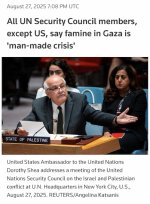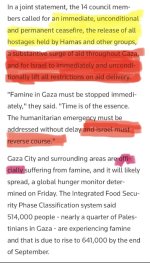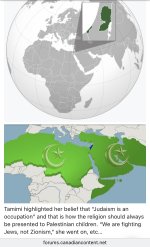Netanyahu will do what's best for Israel I would hope. If not, it's up to the Israeli's to do something about it just as in any other country. BUT, having said that, Israel is entitled to defend themselves & screw everyone else who are against that. It's their very existence that's at stake. That should take priority not the whining from Hamas. Hamas should NEVER be taken seriously because they're not serious & it's not only Israeli's that are hurt but Palestinians as well. Unfortunately, they voted for Hamas so it's on them what's happening. Stop sending bullets & missles into Israel & the war would be over in a minute!!BBC News
Israel must take hostage deal, its military chief reportedly says
25 August 2025, 07:55 BST
Israel's Defense Forces (IDF) chief of staff has said there is a "deal on the table" for the remaining hostages in Gaza, according to Israeli media.
Lt Gen Eyal Zamir reportedly said the Israeli military had brought about the conditions for a deal, and it is now in Prime Minister Benjamin "Netanyahu's hands," Channel 13 News reports.
On Tuesday, Israel's security cabinet is expected to discuss the latest proposal advanced by regional mediators, which Hamas accepted a week ago.
It follows mass demonstrations in Israel earlier this month as hundreds of thousands of people gathered in Tel Aviv, calling for an end to the Gaza war and a deal to secure the release of hostages held by Hamas.
The Hostages and Missing Families Forum said Zamir had voiced "what most Israelis were demanding," including a deal to bring home all 50 remaining hostages, 20 of whom are believed to be alive, and an end to the war.
The group is planning another day of mass protest on Tuesday.
The most recent proposal, from mediators in Egypt and Qatar is said to be based on a framework put forward by US envoy Steve Witkoff in June.
It would see Hamas free around half of the hostages in two rounds during an initial 60-day truce. There would also be negotiations on a permanent ceasefire.
Netanyahu's office previously said that Israel would only accept a deal if "all the hostages are released in one go".
On Saturday, planes and tanks pounded parts of Gaza City as Israel pressed on with its plan to seize the territory's largest urban area.
Benjamin Netanyahu has vowed to defeat Hamas and defied criticism over his plans to expand the war, from the international community and from Zamir himself.
According to Israeli media, Zamir has argued against a full-scale occupation, citing fears of endangering the lives of hostages and miring an exhausted military in Gaza.
The offensive would forcibly displace a million people from Gaza City to camps in the south but Israel has not provided an exact timetable of when its troops would enter Gaza City.
Netanyahu is reported to want the entire city under Israeli occupation from 7 October.
At least 1.9 million people in Gaza – or about 90% of the population – have already been displaced, according to the UN.
Last week a UN-backed hunger monitor said there was now famine in Gaza City and that more than 500,000 people in Gaza were facing "starvation, destitution and death". The UN and aid agencies say this is a direct result of Israeli restrictions on letting food and aid into Gaza. Israel described the monitor's report as an "outright lie", denying there is starvation there.
The war in Gaza was triggered by Hamas's 7 October 2023 attack on Israel, which killed about 1,200 people and saw 251 others taken hostage.
Israel's offensive has killed more than 62,686 Palestinians, according to figures from the Hamas-run Gaza health ministry, which the UN considers reliable.
Hamas attacks Israel
- Thread starter Serryah
- Start date
You are using an out of date browser. It may not display this or other websites correctly.
You should upgrade or use an alternative browser.
You should upgrade or use an alternative browser.
No. Netanyahu does what the Jewish supremacists that prop him up want or he goes to prison for 10 years on corruption and grifting charges.Netanyahu will do what's best for Israel I would hope. If not, it's up to the Israeli's to do something about it just as in any other country. BUT, having said that, Israel is entitled to defend themselves & screw everyone else who are against that. It's their very existence that's at stake. That should take priority not the whining from Hamas. Hamas should NEVER be taken seriously because they're not serious & it's not only Israeli's that are hurt but Palestinians as well. Unfortunately, they voted for Hamas so it's on them what's happening. Stop sending bullets & missles into Israel & the war would be over in a minute!!
The extremists run Israel and they have absolutely no morals. They are the ones who think you and I aren't fully human.
The world doesn't need a Jewish version of the Taliban.
They aren't defending themselves.
Bibi is the man who funded Hamas to keep the secular (Jew, Christian, Muslim and Druze) Palestinian Authority at bay. He needs Hamas or he can't use fear as a weapon against his own people.
Last edited:
According to Israel, if your mom is a Jew, you're a Jew.
Well if we go by that...
Y'all are Muslims too.
Because Muslim is just the overall term for someone who believes in the Abrahamic God.
That's why Moses was a Muslim, Jesus was a Muslim, and every important person in the Torah and Bible are Muslims.
The only reason there's a difference is that there are people who believe Mohammed was the last prophet of God while that isn't the case for others.
So... congrats or something?


Israel asked a global hunger monitor on Wednesday to retractan assessment. Israel dismissed the findings as false and biased, saying the IPC had based its survey on partial data largely provided by Hamas, which did not take into account a recent influx of food, etc…
All UN Security Council members, except US, say famine in Gaza is 'man-made crisis' — Reuters
All United Nations Security Council members, except the United States, on Wednesday said the famine in Gazawas a “manmade crisis” and warned that the use of starvation as a weapon of war is banned under international humanitarian law.
Y'all are Muslims too.
Because Muslim is just the overall term for someone who believes in the Abrahamic God.


But…but maybe to a Muslim Jews and Christian’s are also sorta Muslims?
 Me? I’m on the outside of all of that, as not being religious, it’s all just more or less a curiosity for me.
Me? I’m on the outside of all of that, as not being religious, it’s all just more or less a curiosity for me.I’m shocked (well, not really).Sounds like a good idea to me.

Do they have an issue with Hamas ruled and governed Palestine (the Gaza portion of it anyway)? I’m kinda doubting it….

At the end of World War 2, there where what? 100 countries? A few less? Now there’s 200 countries? A few less? A quarter of those in a block are against Israel’s continued membership in the UN? Again, I’m shocked (well, still, not really).

If Israel didn’t exist, what would the UN have to talk about?

Wait, there’s armed conflicts going on, right now, that don’t involve the Jews? I mean other than Russia/Ukraine? From the news, this hardly seems plausible?
Enough of the "Jew" shit. Why are you pinning this on Jews when the vast majority of Zionists are secular like you?View attachment 30797
View attachment 30798
Israel asked a global hunger monitor on Wednesday to retractan assessment. Israel dismissed the findings as false and biased, saying the IPC had based its survey on partial data largely provided by Hamas, which did not take into account a recent influx of food, etc…

All UN Security Council members, except US, say famine in Gaza is 'man-made crisis' — Reuters
All United Nations Security Council members, except the United States, on Wednesday said the famine in Gazawas a “manmade crisis” and warned that the use of starvation as a weapon of war is banned under international humanitarian law.apple.news
View attachment 30799
View attachment 30800
But…but maybe to a Muslim Jews and Christian’s are also sorta Muslims?
View attachment 30805Me? I’m on the outside of all of that, as not being religious, it’s all just more or less a curiosity for me.
I’m shocked (well, not really).
View attachment 30801
Do they have an issue with Hamas ruled and governed Palestine (the Gaza portion of it anyway)? I’m kinda doubting it….
View attachment 30802
At the end of World War 2, there where what? 100 countries? A few less? Now there’s 200 countries? A few less? A quarter of those in a block are against Israel’s continued membership in the UN? Again, I’m shocked (well, still, not really).
View attachment 30804
If Israel didn’t exist, what would the UN have to talk about?
View attachment 30806
Wait, there’s armed conflicts going on, right now, that don’t involve the Jews? I mean other than Russia/Ukraine? From the news, this hardly seems plausible?
Does Israel fully participate in the UN and ICJ? Are they signatories of the NPT?
Why not?
I'll ask one more time and I wont accept "because they hate Jews". Why did Hamas attack Israel? Was the attack legal?
Guess what? Islam isn't out to get you.
Is this just your talking point for you in debate? Is this how the 57 or whatever Muslim dominated nations see this? You claim to draw a line between Jews & Zionists…but you, if you’re being sincere, might be one of the exceptions in this definition.Enough of the "Jew" shit. Why are you pinning this on Jews when the vast majority of Zionists are secular like you?
Are they? Do they? There’s 195 countries (194 of them aren’t predominantly Jewish), and how many of those meet your criteria and requirements (?) or they’re not relevant? If not then why?Does Israel fully participate in the UN and ICJ? Are they signatories of the NPT?
Yes. Why not?Why not?
Well, I know I’m probably wrong because I don’t think the same way that you do, but, from the outside looking in and not being religious myself…& reading much of what I’ve read over the last almost 2 years, I think it’s about religion.I'll ask one more time and I wont accept "because they hate Jews". Why did Hamas attack Israel?
There’s all kinds of justification and excuses, but I think it comes down to religion. Those Jewish people in Israel are on land that Islam once claimed as it’s own, thus it’s supposedly suppose to be forever, like Spain or India, etc…
Depends who you ask. What does “legal” really mean in this sense?Was the attack legal?
Cool. Not worried about it. Are you worried that Islam or Judaism are out to get to you (?) or that either are a threat to your religion? Neither are a threat to my non-religion.Guess what? Islam isn't out to get you.
What does the Canadian (non- Hamas) sourced data have to say?Israel asked a global hunger monitor on Wednesday to retractan assessment. Israel dismissed the findings as false and biased, saying the IPC had based its survey on partial data largely provided by Hamas, which did not take into account a recent influx of food, etc…
- In the first two weeks of August, 61% of pregnant women and new mothers screened at Save the Children’s clinics have been found to be malnourished, nearly seven times higher than the rate in the first two weeks of March (9%), before aid and goods were almost completely cut off.
- Doctors in Save the Children health clinics are seeing around 100 patients a day, double the number of their recommended caseload.
- Save the Children has been unable to get any of its own aid into Gaza since 2 March and has 45 trucks-worth of aid including medicines, shelter items and hygiene kits waiting in warehouses.
- Save the Children is responding to the famine crisis in Gaza in our two primary healthcare clinics in Khan Younis and Deir al-Balah by providing nutrition screening and treatment to children under 5, pregnant and breastfeeding mothers. Our treatment package includes providing medical interventions, supplements and high calorie biscuits and pastes to malnourished children and mothers. Since the start of the war, our two clinics have helped over 113,000 people, including over 42,000 children.
- According to the IPC, through June 2026, at least 132,000 children under the age of five are at risk of death from acute malnutrition. This number has doubled compared to the IPC estimates reported in May 2025.
Are they lying because they hate Jews?
Have you ever heard of yes and no answers?Is this just your talking point for you in debate? Is this how the 57 or whatever Muslim dominated nations see this? You claim to draw a line between Jews & Zionists…but you, if you’re being sincere, might be one of the exceptions in this definition.
Are they? Do they? There’s 195 countries (194 of them aren’t predominantly Jewish), and how many of those meet your criteria and requirements (?) or they’re not relevant? If not then why?
Yes. Why?
Well, I know I’m probably wrong because I don’t think the same way that you do, but, from the outside looking in and not being religious myself…& reading much of what I’ve read over the last almost 2 years, I think it’s about religion.
There’s all kinds of justification and excuses, but I think it comes down to religion. Those Jewish people in Israel are on land that Islam once claimed as it’s own, thus it’s supposedly suppose to be forever, like Spain or India, etc…
Depends who you ask. What does “legal” really mean in this sense?
Cool. Not worried about it. Are you worried that Islam or Judaism are out to get to you (?) or that either are a threat to your religion? Neither are a threat to my non-religion.
Does Israel fully participate in and recognize the authority of the UN and ICJ?
It's not my standards bub. Why would they be? Are you claiming I'm the UN and the leader of 195 nations?
Where do they get their data from? The Vatican? Botswana? Some source that’s not involved as a belligerent in this conflict, that’s not Israeli or Hamas controlled?
I know I’ve tried many times with yes or no answers to questions with you and you just skate around them unless it fits your world view…so it is what it is.Have you ever heard of yes and no answers?
You’re just gonna single out the 1/195th country to make your point, which is making my point.Does Israel fully participate in the UN and ICJ?
I’m not claiming you are anything but yourself. You’re the one chronically accusing me of being a paid stooge of the Israeli’s, etc…and that’s not true either. I just happen to have a different opinion than you.It's not my standards bub. Why would they be? Are you claiming I'm the UN and the leader of 195 nations?
The name save the children is in the post.
Ever thought of simply trying www.savethechildren.ca?
So thats a no. Why don't they fully participate and recognize the UN and ICJ? They hate Goyim?
Why did Hamas attack on Oct 7? Get a statement made by Hamas not what you think. I'll tell you this, it's not religion.
Ever thought of simply trying www.savethechildren.ca?
So thats a no. Why don't they fully participate and recognize the UN and ICJ? They hate Goyim?
Why did Hamas attack on Oct 7? Get a statement made by Hamas not what you think. I'll tell you this, it's not religion.
I try to keep up while cooking supper and text to talking which isn’t being my friend at this point. Where did they get their data from? You’re the one throwing out the link.The name save the children is in the post.
Ever thought of simply trying www.savethechildren.ca?
So thats a no. Why don't they fully participate and recognize the UN and ICJ? They hate Goyim?
It's their own fucking data from their own fucking clinics. All you have to do is read. You don't trust Canadians? Are they Hamas too?I try to keep up while cooking supper and text to talking which isn’t being my friend at this point. Where did they get their data from? You’re the one throwing out the link.
It's their own fucking data from their own fucking clinics. All you have to do is read. You don't trust Canadians? Are they Hamas too?

Catching up a bit. Doubt the Jews or Muslims would be in approval of my dietary choices tonight. I’m doing this as I was getting supper prepped and then into a steamer. I’m not retired and I work full-time still at this point, and I try and fit in everything that I do into a 24 hour day.
Should I research the data source for your link at this point, or should I police my backyard (we do have four dogs) so that when I make it out to the deck, there’s gonna be a whole lot less flies? Hmmmm….
www.savethechildren.caView attachment 30808
Catching up a bit. Doubt the Jews or Muslims would be in approval of my dietary choices tonight. I’m doing this as I was getting supper prepped and then into a steamer. I’m not retired and I work full-time still at this point, and I try and fit in everything that I do into a 24 hour day.
Should I research the data source for your link at this point, or should I police my backyard (we do have four dogs) so that when I make it out to the deck, there’s gonna be a whole lot less flies? Hmmmm….
The other question....
The reasons for Hamas's attack on Israel on October 7, 2023, are complex and multifaceted, rooted in a combination of longstanding grievances, strategic calculations, and regional dynamics.
Based on available information, Hamas's stated motivations and the broader context suggest the following key factors:
Response to Israeli Occupation and Policies:
Hamas justified the attack, named Operation Al-Aqsa Flood, as a reaction to Israel's ongoing occupation of Palestinian territories, including the Gaza Strip and West Bank, which Israel has controlled since the 1967 Six-Day War. Specific grievances included the blockade of Gaza, enforced by Israel and Egypt since 2007, which restricted movement and trade, exacerbating economic hardship.
Hamas also cited escalating Israeli settler violence in the West Bank, expansion of illegal settlements, and perceived violations at the Al-Aqsa Mosque compound in Jerusalem, a site of religious significance.
These actions were seen as intensifying Palestinian desperation and necessitating a response.
Disrupting Israel-Saudi Normalization:
Documents recovered by Israeli forces in Gaza suggest a primary strategic goal was to derail normalization talks between Israel and Saudi Arabia. Hamas leaders, including Yahya Sinwar, viewed a potential Israel-Saudi deal as an existential threat, as it could further isolate Hamas and diminish the Palestinian cause in regional politics. The attack was intended to disrupt these talks, which were part of a broader U.S.-led effort following the Abraham Accords, by reigniting focus on the Palestinian issue and embarrassing Arab leaders pursuing peace with Israel.
Regional Dynamics and Iranian Support:
Hamas's attack was influenced by its realignment with Iran and the broader "axis of resistance," including Hezbollah and Syria, after strained relations during the Arab Spring. Improved ties with Iran provided Hamas with military support, including weapons and training, emboldening the group. The attack aligned with Iran's interest in disrupting Israel’s regional integration, though Iran denied direct involvement. The timing also capitalized on perceived Israeli vulnerabilities, such as military focus on the West Bank and domestic political turmoil.
Tactical and Political Objectives:
Hamas aimed to achieve immediate tactical goals, such as capturing hostages to exchange for Palestinian prisoners held in Israeli jails and deterring further Israeli aggression at Al-Aqsa Mosque. The attack was meticulously planned over months or years, using Gaza’s tunnel network for covert communication and involving coordinated rocket barrages, land incursions, and paraglider assaults. Hamas sought to shift regional power dynamics and reassert its relevance against the Palestinian Authority, though it lacked a clear long-term strategy.
Exploitation of Israeli Vulnerabilities:
The attack exploited Israel’s intelligence and military failures, including overconfidence in the Gaza barrier and assumptions that Hamas was deterred by prior conflicts. Internal Israeli political instability, driven by judicial reform protests and a far-right government, further distracted from Gaza’s security, creating an opportunity for Hamas to execute a surprise assault.
While these factors provide insight into Hamas’s motivations, the attack’s scale—killing 1,195 people, including 736 civilians, and taking 251 hostages—provoked a massive Israeli response, complicating Hamas’s ability to achieve lasting political gains. The operation succeeded in disrupting normalization talks but at a significant cost, with Gaza facing devastating retaliation.
This analysis avoids consensus-based conclusions and relies on primary motivations cited by Hamas and documented evidence, while acknowledging the complexity of the Israeli-Palestinian conflict.
Kill all Jews isn't in there anywhere.
Do you truly think this ends with Bibi's Hamas? Do you truly believe Israel didn't infiltrate the fuck out of Hamas when Bibi started funding and backing them? Do you have a reason why they wouldn't? I know I would if I wanted to run decades long narratives.Isn’t something like that in the original Hamas Charter? From the River to the Sea or something like that? I can look it up when I have both hands free, or anybody here can. Talk about timing, I’m gonna have to circle back to this again later.
View attachment 30809
What does the Revisionist Zionist or Likud or Jew Power or Religious Zionist charters say?
Expell all Goyim (Muzzies and Christians) from Palestine(Jordan), parts of Lebanon, Syria, Egypt and Saudi Arabia?
Euphrates to the Sea.
Why do they believe it's theirs?
After Hamas will you get a boner for the Jordanian resistance when tanks roll into the East Bank? Historically they are Palestinians too and BTW semites. The tribes of Shem.

Do Palestinians not have a right to defend themselves and fight for their land? Are they sub-human like us?
Yes? No?
Then there is christian Zionists.Do you truly think this ends with Bibi's Hamas? Do you truly believe Israel didn't infiltrate the fuck out of Hamas when Bibi started funding and backing them? Do you have a reason why they wouldn't? I know I would if I wanted to run decades long narratives.
What does the Revisionist Zionist or Likud or Jew Power or Religious Zionist charters say?
Expell all Goyim (Muzzies and Christians) from Palestine(Jordan), parts of Lebanon, Syria, Egypt and Saudi Arabia?
Euphrates to the Sea.
Why do they believe it's theirs?
After Hamas will you get a boner for the Jordanian resistance when tanks roll into the East Bank? Historically they are Palestinians too and BTW semites. The tribes of Shem.
View attachment 30811
Do Palestinians not have a right to defend themselves and fight for their land? Are they sub-human like us?
Yes? No?
How cool are you with being a participant in this shit?

What these red cows from Texas have to do with war and peace in the Middle East
Some Jews and Christians believe these Texas red heifers are the key to rebuilding a Jewish temple in Jerusalem, and to beckoning the Messiah.
I want absolutely nothing to do with this bull(heifer)shit.
Well, I’ve got a portion of an hour before I have to be at work, and I’m still gonna have a shower and I’m still gonna get shaved, & let’s see what we can do here.
Hamas's 2017 charterremoved the antisemitic language and clarified Hamas's struggle is with Zionists, not Jews. Hmmm.

Anywho, back to that Oct 7th thing:

 en.wikipedia.org
en.wikipedia.org
I’m running out’a time. I’ll have to come back to this later.
Enough of the "Jew" shit. Why are you pinning this on Jews when the vast majority of Zionists are secular like you?
Huh, it’s almost like you’re using the terms Zionist & Jew interchangeable. Weird…What does the Revisionist Zionist or Likud or Jew Power or Religious Zionist charters say?
Who are Hamas anyway? What’s their deal?This analysis avoids consensus-based conclusions and relies on primary motivations cited by Hamas and documented evidence, while acknowledging the complexity of the Israeli-Palestinian conflict.
Kill all Jews isn't in there anywhere.
I’m thinking it’s religion. Religion & religious real estate. It’s been the justification for a lot of horrible shit over time, up to & including the present.Why did Hamas attack on Oct 7? Get a statement made by Hamas not what you think. I'll tell you this, it's not religion.
The Covenant of the Islamic Resistance Movement (Arabic: ميثاق حركة المقاومة الإسلامية حماس), referred to as the Hamas Covenant or Hamas Charter, was issued by Hamas (the Islamic Resistance Movement) on 18 August 1988 and outlines the organization's founding identity, positions, and aims. In 2017, Hamas unveiled a revised charter, without explicitly revoking the 1988 charter. Hmmm…Well, I know I’m probably wrong because I don’t think the same way that you do, but, from the outside looking in and not being religious myself…& reading much of what I’ve read over the last almost 2 years, I think it’s about religion.
Hamas's 2017 charterremoved the antisemitic language and clarified Hamas's struggle is with Zionists, not Jews. Hmmm.
Enough of the "Jew" shit. Why are you pinning this on Jews when the vast majority of Zionists are secular like you?
The original Charter identified Hamas as the Muslim Brotherhood in Palestine and described its members to be god-fearing Muslims raising the banner of Jihad (armed struggle) in "the face of the oppressors". The charter defines the struggle to be against the Jews (not Zionists? Queer) and calls for the eventual creation of an Islamic Palestinian state in all of former Mandatory Palestine, and the obliteration or dissolution of Israel. That sounds almost…genocidal…in its nature.Is this just your talking point for you in debate? Is this how the 57 or whatever Muslim dominated nations see this? You claim to draw a line between Jews & Zionists…but you, if you’re being sincere, might be one of the exceptions in this definition.

Anywho, back to that Oct 7th thing:
What does it say in Hamas’s original charter about this? Palestine is sacred (waqf) for all Muslims for all time, and it cannot be relinquished by anyone.There’s all kinds of justification and excuses, but I think it comes down to religion. Those Jewish people in Israel are on land that Islam once claimed as it’s own, thus it’s supposedly suppose to be forever, like Spain or India, etc…

Waqf - Wikipedia
I’m running out’a time. I’ll have to come back to this later.
What wrong with the revised Hamas Charter?Well, I’ve got a portion of an hour before I have to be at work, and I’m still gonna have a shower and I’m still gonna get shaved, & let’s see what we can do here.
Huh, it’s almost like you’re using the terms Zionist & Jew interchangeable. Weird…
Who are Hamas anyway? What’s their deal?
I’m thinking it’s religion. Religion & religious real estate. It’s been the justification for a lot of horrible shit over time, up to & including the present.
The Covenant of the Islamic Resistance Movement (Arabic: ميثاق حركة المقاومة الإسلامية حماس), referred to as the Hamas Covenant or Hamas Charter, was issued by Hamas (the Islamic Resistance Movement) on 18 August 1988 and outlines the organization's founding identity, positions, and aims. In 2017, Hamas unveiled a revised charter, without explicitly revoking the 1988 charter. Hmmm…
Hamas's 2017 charterremoved the antisemitic language and clarified Hamas's struggle is with Zionists, not Jews. Hmmm.
The original Charter identified Hamas as the Muslim Brotherhood in Palestine and described its members to be god-fearing Muslims raising the banner of Jihad (armed struggle) in "the face of the oppressors". The charter defines the struggle to be against the Jews (not Zionists? Queer) and calls for the eventual creation of an Islamic Palestinian state in all of former Mandatory Palestine, and the obliteration or dissolution of Israel. That sounds almost…genocidal…in its nature.
View attachment 30812
Anywho, back to that Oct 7th thing:
What does it say in Hamas’s original charter about this? Palestine is sacred (waqf) for all Muslims for all time, and it cannot be relinquished by anyone.

Waqf - Wikipedia
en.wikipedia.org
I’m running out’a time. I’ll have to come back to this later.
Didn't fit your bullshit?
In 2017, the group created a new policy document to supplement its original 1988 charter. In the document, HAMAS affirmed its conflict with Israel was due to occupation, not religion, and stated it would accept the creation of a Palestinian state within the 1967 borders without recognizing Israel.
HAMAS | New Jersey OHSP
The original 1977 party platform stated that "between the Sea and the Jordan there will only be Israeli sovereignty."[137][138]
The 1999 Likud Party platform emphasized the right of settlement:
The Jewish communities in Judea, Samaria, and Gaza are the realization of Zionist values. Settlement of the land is a clear expression of the unassailable right of the Jewish people to the Land of Israel and constitutes an important asset in the defense of the vital interests of the State of Israel. The Likud will continue to strengthen and develop these communities and will prevent their uprooting.[139]
Similarly, they claim the Jordan River as the permanent eastern border to Israel and it also claims Jerusalem as belonging to Israel.
The 'Peace & Security' chapter of the 1999 Likud Party platform rejects a Palestinian state:
The Government of Israel flatly rejects the establishment of a Palestinian Arab state west of the Jordan river. The Palestinians can run their lives freely in the framework of self-rule, but not as an independent and sovereign state. Thus, for example, in matters of foreign affairs, security, immigration, and ecology, their activity shall be limited in accordance with imperatives of Israel's existence, security and national needs.[139]
The platform of racists.
Who are these people? Do they have rights to somebody else's nation? Yes or no?
They sound like racist terrorists who have no problem with ethnic cleansing or the liquidation of the occupants of land they don't have a claim to. Fucking savages.
PS I never named the the Jew Power political party led by Shitamar Ben-Gvir....
Remember him, the guy you pegged as "klan". He holds Israel by the balls.
Do you support a Zionist Taliban? Yes? No?
Last edited:
